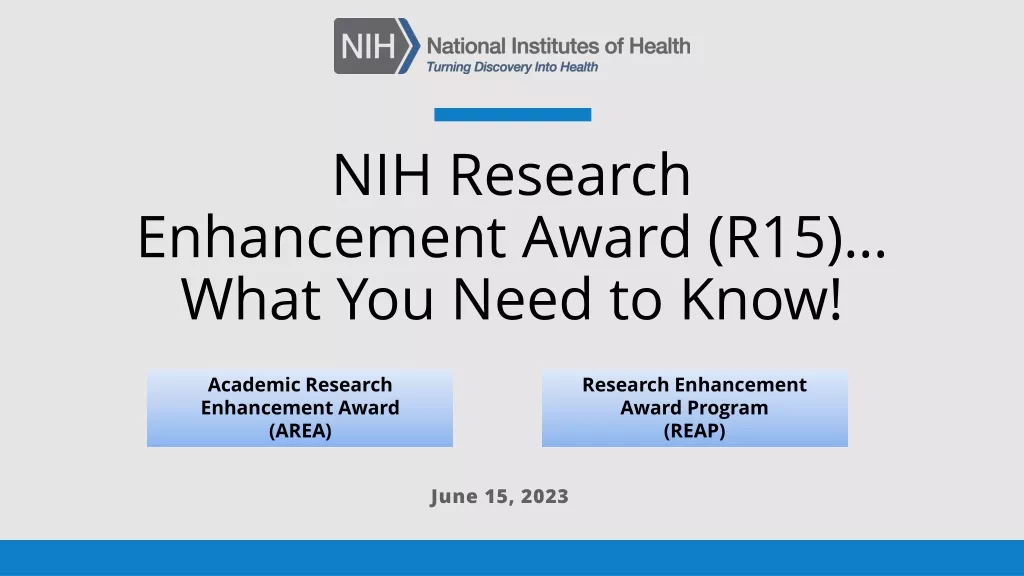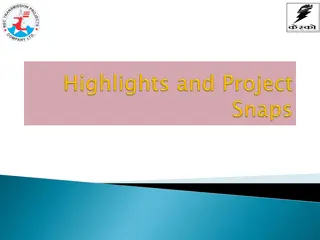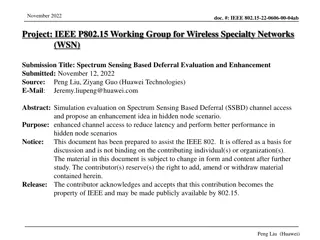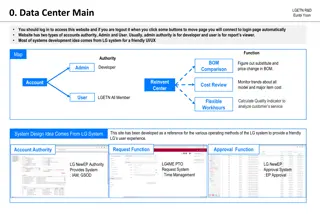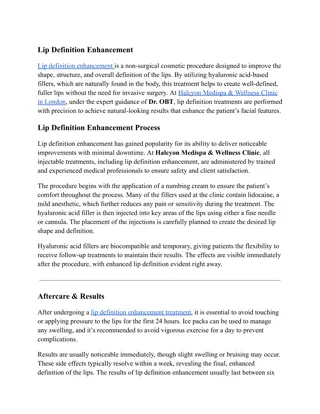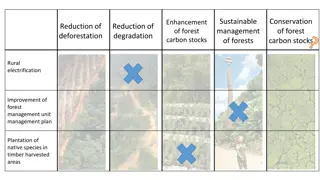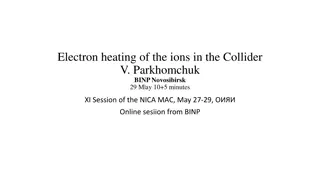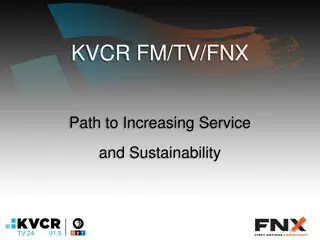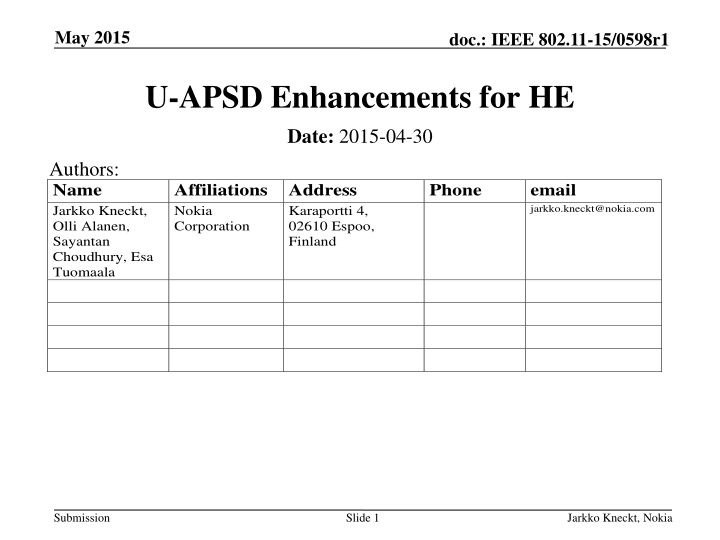
IEEE 802.11-15/0598r1 U-APSD Enhancements for HE
Explore the enhancements to U-APSD proposed in the May 2015 document, focusing on improvements in power-saving mechanisms for wireless communication devices. The submission presents simulation results to support the enhancements, including changes related to service period control and data flow optimization. Discover how these enhancements aim to reduce overhead, enhance efficiency, and promote power-saving benefits for devices operating in wireless networks.
Download Presentation

Please find below an Image/Link to download the presentation.
The content on the website is provided AS IS for your information and personal use only. It may not be sold, licensed, or shared on other websites without obtaining consent from the author. If you encounter any issues during the download, it is possible that the publisher has removed the file from their server.
You are allowed to download the files provided on this website for personal or commercial use, subject to the condition that they are used lawfully. All files are the property of their respective owners.
The content on the website is provided AS IS for your information and personal use only. It may not be sold, licensed, or shared on other websites without obtaining consent from the author.
E N D
Presentation Transcript
May 2015 doc.: IEEE 802.11-15/0598r1 U-APSD Enhancements for HE Date: 2015-04-30 Authors: Name Jarkko Kneckt, Olli Alanen, Sayantan Choudhury, Esa Tuomaala Affiliations Address Nokia Corporation Phone email jarkko.kneckt@nokia.com Karaportti 4, 02610 Espoo, Finland Submission Slide 1 Jarkko Kneckt, Nokia
May 2015 doc.: IEEE 802.11-15/0598r1 Abstract In March 2015 meeting, submission 15-0326r0 presented two enhancements to U-APSD [1]. This submission presents simulation results to justify the enhancements. Submission Slide 2 Jarkko Kneckt, Nokia
May 2015 doc.: IEEE 802.11-15/0598r1 Recap of enhancement 1 AP could end the service period with an acknowledgement frame EOSP bit included to ACK or BA frame AP could end the service period if: STA has indicated (more bit) in the data PDU that it has no more UL data and AP has no more DL data in its buffers Gains The number of transmitted frames in U-APSD traffic flow is reduced (= less overhead) The STA needs to operate shorter time in Awake state (= more power save) Submission Slide 3 Jarkko Kneckt, Nokia
May 2015 doc.: IEEE 802.11-15/0598r1 Recap of enhancement 2 STA could control the initiation of the service period A trigger / no-trigger field is included to the trigger frame In many cases, this is results to the same data flow as EOSP in ACK In co-existence cases a STA may, the control the operating time in BSS with trigger field This is useful in concurrent operation, e.g. when STA should switch to P2P network Submission Slide 4 Jarkko Kneckt, Nokia
May 2015 doc.: IEEE 802.11-15/0598r1 Example of data flow with current U-APSD In the current U-APSD operation, the transmission of EOSP field in QoS-Null frame may be delayed due to transmissions of other STAs Depending on the case, this may seriously delay the beginning of operation in Doze state Data Ack STA-1 Doze STA-1 could sleep this time with the proposed enhancements. Data STA-2 Contention EOSP Ack Null Ack AP Contention Submission Slide 5 Jarkko Kneckt, Nokia
May 2015 doc.: IEEE 802.11-15/0598r1 Simulation scenario A subset of 11ax scenario 2 2 laptops (STA) and 2 wireless monitors (AP) Laptops stream UDP 4k video to the corresponding monitors 250Mbps with 50 packets per second 2 m 2 m STA1 STA1 STA4 STA4 2 m 2 m STA2 STA2 STA3 STA3 2x2 MIMO, 80MHz, 256QAM 5/6, TxP 10dBm Jarkko Kneckt, Nokia Submission Slide 6
May 2015 doc.: IEEE 802.11-15/0598r1 Simulation results In all the simulation drops, all the data (2x250Mbps) was served Normal U-APSD and U- APSD with EOSP in ACK have large difference in the proportion of time spent in Doze state Submission Slide 7 Jarkko Kneckt, Nokia
May 2015 doc.: IEEE 802.11-15/0598r1 Summary The U-APSD enhancements make power save performance more reliable and tolerable to other STAs transmissions The U-APSD enhancements are simple and increase the time STAs can operate in sleep state Submission Slide 8 Jarkko Kneckt, Nokia
May 2015 doc.: IEEE 802.11-15/0598r1 References [1] 11-15-0326r0 - U-APSD Enhancements for HE Submission Slide 9 Jarkko Kneckt, Nokia
May 2015 doc.: IEEE 802.11-15/0598r1 Strawpoll Do you agree that the presented U-APSD enhancements reduce power consumption of a non-AP STA in the presented scenario? Submission Slide 10 Jarkko Kneckt, Nokia


